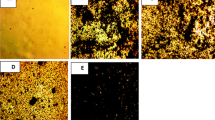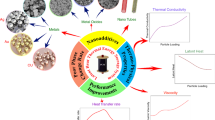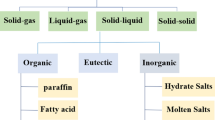Abstract
Energy storage requirement is increasing day by day for all of us. Although the main demand comes in the form of electrical energy for the biomedical sector by utilizing thermal energy found via solar radiation. Phase-change materials (PCM) have been used in the energy storage device. In this work, we briefly discussed the melting, crystallization temperature, latent heat, and thermal stability of the synthesized sample, such as OM35-PCM highlighted. One of the promising materials is chosen based on the low melting enthalpy. Thermal analyses were performed to study its thermal conductivity and stability. OM35 with nanomaterial shows the linear response in thermal stability. This PCM becomes an attractive material to store the thermal energy and then further converted it into electrical energy. This work has a wide range of biomedical, solar power plant, and metrology applications. Differential scanning calorimetry (DSC) measurements were used to determine the melting point and enthalpy of fusion of OM35-PCM. Melting started peaked at 44.5 °C. The structural and morphological characteristics of nanocomposite PCM were investigated by X-ray diffraction (XRD) and a high-resolution transmission electron microscope (HRTEM). C Therm Trident system is used to analyze the thermal conductivity of nanocomposite OM35 PCM, which is seen to improve 0.4 W/mk. Nano-PCM of thermal conductivity is the best choice for low-temperature applications.









Similar content being viewed by others
References
Arenberg R, Zelinsky D, Epstein M (2010) Heat transfer efficient thermal energy storage for steam generation. Energy Convers Manage 51:9–15
Haghighi A, Babapoor A, Azizi M, Javanshir Z, Ghasemzade H (2020) Optimization of the thermal performance of PCM nanocomposites. J Energy Manag Technol 4(2):14–19
Indirani S, Arjunan SP, Jeyashree Y, Ram GNS, Krishna BM, Manohar YB (2019) Design and validation of MEMS-based micro energy harvesting and thermal energy storage device. Mater Res Express 6(11):115511
Kenisarin M, Mahkamov K (2007) Solar energy storage using phase change materials. Renew Sustain Energy Rev 11(9):1913–1965
Kiziroglou ME, Wright SW, Toh TT, Mitcheson PD, Becker T, Yeatman EM (2013) Design and fabrication of heat storage thermoelectric harvesting devices. IEEE Trans Industr Electron 61(1):302–309
Li X, Zhou Y, Nian H, Zhang X, Dong O, Ren X, Zeng J, Hai C, Shen Y (2017) Advanced nanocomposite phase change material based on calcium chloride hexahydrate with aluminum oxide nanoparticles for thermal energy storage. Energy Fuels 31(6):6560–6567
Manickam R, Kalidoss P, Suresh S, Venkatachalapathy S (2019) Erythritol-based Nano-PCM for Solar thermal energy storage. Int Res J Eng Technol 6:1631–1636
Mondal S (2008) Phase change materials for smart textiles–an overview. Appl Therm Eng 28(11–12):1536–1550
Salinas A, Lizcano M, Lozano K (2015) Synthesis of β-SiC fine fibers by the force spinning method with microwave irradiation. J Ceram. https://doi.org/10.1155/2015/217931
Saxena R, Rakshit D, Kaushik SC (2018) Experimental assessment of characterised PCMs for thermal management of buildings in tropical composite climate. In: Proceedings of the 4th world congress on mechanical, chemical, and material engineering (MCM'18), Madrid, Spain, pp HTFF 170-1–HTFF 170-9
Sheng QQ, Zhang XL (2008) Research about the wax composite phase change materials. Refrig Air Cond Electr Power Mach 2(18–20):31
Sridharan G, Harikrishnan S (2018) Improved performance of composite phase change material for thermal energy storage. Mater Today Proc 5:14215–14224
Tan FL, Tso CP (2004) Cooling of mobile electronic devices using phase change materials. Appl Therm Eng 24(2–3):159–169
Wang X, Li C, Zhao T (2018) Fabrication and characterization of poly (melamine-formaldehyde)/silicon carbide hybrid microencapsulated phase change materials with enhanced thermal conductivity and light-heat performance. Sol Energy Mater Sol Cells 183:82
Wu B, Fu W, Kong B, Hu K, Zhou C, Lei J (2018) Preparation and characterization of stearic acid/polyurethane composites as dual-phase change material for thermal energy storage. J Therm Anal Calorim 132(2):907–917
Zhang D, Tian S, Xiao D (2007) Experimental study on the phase change behavior of phase change material confined in pores. Solar Energy 81(5):653–660
Zhang HL, Fang X, Zhao Y (2014a) Progress in phase change materials and technologies. Mater Rev 28(13):26–32
Zhang HL, Fang XD, Zhao YJ (2014b) Progress in phase change materials and technologies. Mater Rev 28(26–32):3
Zou DQ, Ma XF, Liu XS, Zhang PJJ, Hu YP (2018) Thermal performance enhancement of composite phase change materials (PCM) using graphene and carbon nanotubes as additives for the potential application in lithium-ion power battery. Int J Heat Mass Transf 120:33–41
Author information
Authors and Affiliations
Corresponding author
Additional information
Publisher's Note
Springer Nature remains neutral with regard to jurisdictional claims in published maps and institutional affiliations.
Supplementary Information
Below is the link to the electronic supplementary material.
Rights and permissions
Springer Nature or its licensor holds exclusive rights to this article under a publishing agreement with the author(s) or other rightsholder(s); author self-archiving of the accepted manuscript version of this article is solely governed by the terms of such publishing agreement and applicable law.
About this article
Cite this article
Indirani, S., Arjunan, S. Selection and synthesis of thermal energy storage PCM with silicon carbide for biomedical applications. Appl Nanosci 12, 2915–2922 (2022). https://doi.org/10.1007/s13204-022-02584-6
Received:
Accepted:
Published:
Issue Date:
DOI: https://doi.org/10.1007/s13204-022-02584-6




